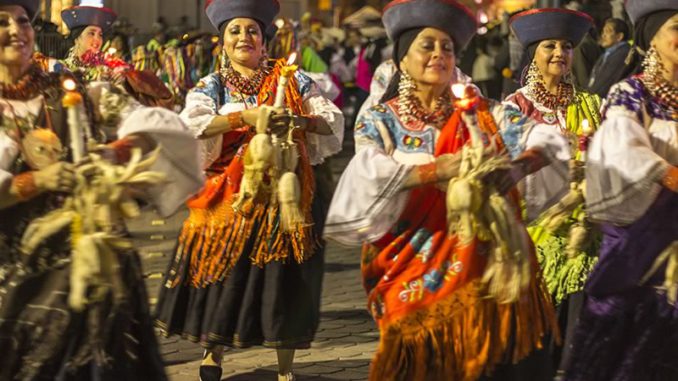The festivities of Ecuador are probably the most colorful, full of culture and traditions in South America. Easter, Inti Raymi, Carnival, and many more. We will immerse ourselves in each of these multiple cultural traditions, which will probably be the best way to get to know the country and its people. Ecuador festivities
If you are planning to visit Ecuador, here you will find a list of the best Ecuadorian festivities and traditional customs. Take a look and be sure to be part of these when you visit Ecuadorian land. The list below is detailed chronologically (month by month) to make your travel itinerary easier.
1. The Diablada de Píllaro in January.
This strange celebration takes place in Píllaro (north of the province of Tungurahua, near the City of Baños) between January 1 and 6 of each year. Thousands of little devils take to the streets to dance in the Diablada. This Ecuadorian festival brings together the entire town and its visitors alike. The three main characters are El «Diablo», Guaricha and Capariche. The beauty of this holiday is that it originated a long time ago, in colonial times, and it brings back to life the indigenous rebellion against the Catholic religion. The Devil Costume is a rejection of the priests, the physical, psychological, economic and moral abuse caused by the Spanish conquerors.
2. Carnival (Ecuadorian Mardi Gras) in February or March
The exact date of this holiday varies from year to year. The reason for this lies in a very old Catholic tradition. Carnival must start on Monday or Tuesday, 40 days before each Easter, before the Catholic fasting period that takes place in mid-February. In Ecuador there is a festival of ancient indigenous traditions which is celebrated on the second full moon by throwing flowers, water and flour. This is a period of celebration and abundance before the fast. Although it takes place throughout the country, Guaranda and Ambato are the main cities where this beautiful tradition is celebrated.

3. Easter in April (Quito)
A deeply theatrical tradition, Semana Santa in Ecuador brings together iconic characters in a procession that recreates Christ's journey to the cross. This Ecuadorian holiday begins on the second Sunday of April. If you find yourself in Quito during this period, be sure to attend one of the many processions and immerse yourself in this tradition. However, the Procession of Jesús del Gran Poder is the best of all and you cannot miss it, it takes place in the beautiful historic center of Quito. Make sure you arrive on time, as it is always full of people.

4. Inti Raymi (Sun Festival) in June and July
The Inti Raymi celebrations take place during the months of June and July, however, the largest of its festivities takes place on June 2. It is a clearly indigenous tradition, the Festival of the Sun begins with the sunset of the longest night of the year. As soon as Andean summer begins, the Inti Raymi is a celebration that honors the sun. The celebration also coincides with the harvest season and the end of the Andean agricultural cycle. This festival involves traditional dances (San Juan) and drinks (Chicha de Jora). A colorful and joyful event, symbolizing new beginnings.

5. The Yamor Festival (Corn Festival) in September
The Yamor festivities began 52 years ago. It is a celebration of the intercultural towns of Otavalo. It combines the celebration of Koya Raymi (the ritual of the moon and the sun as elements of fertility) with Catholic traditions. The word "Yamor" refers to a traditional drink, which is made from seven varieties of corn and is unique in this area. This drink is available during the holidays. The indigenous groups of Kichwa Cayambi and Kichwa Otavalo honor the Andean agricultural cycle by highlighting corn that is considered a symbol of fertility. The festivities include processions, music, dancing in the streets, fireworks, cockfights, mock bullfights and lots of fun. If you want to be part of this beautiful festival, do not forget to visit Otavalo during the Inti Raymi season so that you can have a broader perspective of this festival.

6. La Mama Negra in September and November
The La Mama Negra Festival takes place in Latacunga in late September and again during the week of November. La Mama Negra is one of the oldest traditions and is a sample of the many cultural influences of its Spanish, Aymara, Inca, Mayan and African ancestors. The streets of this beautiful city are filled to see a parade of legendary characters pass by, giving blessing sweets and homemade concoctions. The festival was established when the Cotopaxi volcano erupted in 1742. The locals of the region asked the Virgen de la Merced, the patron saint of Cotopaxi, to forgive Latacunga. When the city escaped the wrath of the volcano, this annual celebration was established in its honor
7. Old Year (New Years Eve) on December 31
This is one of the funniest celebrations in Ecuador and it takes place at the end of each year. It carries several traditions, but the most notorious is the burning of the Old Year puppets. These are made from newspaper, sawdust, and cardboard depicting political figures, characters, or even loved ones. They symbolize the experiences and events of the past year. Burning symbolizes the beginning of new experiences and better things to come. The Widows are men dressed as women who personify the mourning for the Old Year figure who is about to die.


No hay comentarios:
Publicar un comentario